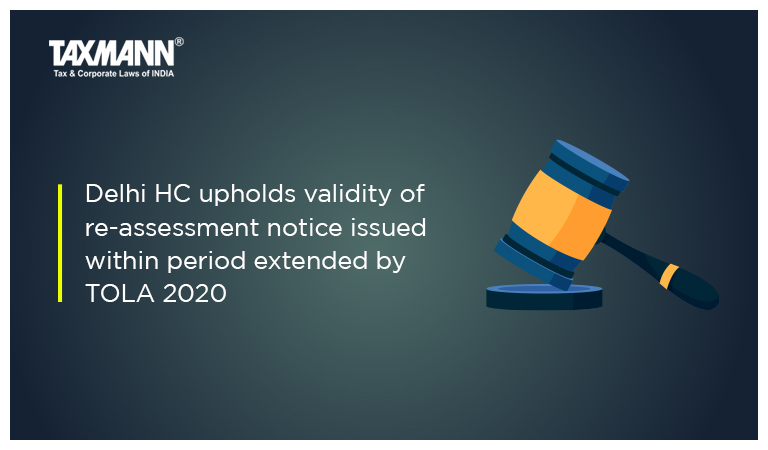Delhi HC upholds validity of re-assessment notice issued within period extended by TOLA 2020
- Blog|News|Income Tax|
- 3 Min Read
- By Taxmann
- |
- Last Updated on 19 September, 2022

Case Details: Touchstone Holdings (P.) Ltd v. Income Tax Officer - [2022] 142 taxmann.com 336 (Delhi)
Judiciary and Counsel Details
-
- Manmohan & Ms Manmeet Pritam Singh Arora, JJ.
- Salil Aggarwal, Sr. Adv. & Madhur Aggarwal, Adv. for the Appellant.
- Puneet Rai, Sr. Standing Counsel, Ms. Adeeba Mujahid, Jr. Standing Counsel & Nikhil Jain, Advs. for the Respondent.
Facts of the Case
A writ petition was filed challenging the order passed under Section 148A(d) of the Income-tax Act 1961, (‘the Act’) pursuant to a notice issued under Section 148 of the Act for the Assessment Year 2013-14 and the CBDT Instruction No. 1/2022 dated 11-05-2022.
The assessee-company submitted that as per the first proviso to Section 149 of the Act (as amended by Finance Act, 2021), no notice for re-assessment can be issued for the AY 2013-14, as the time limit for initiating the proceedings expired on 31-03-2020, as per the provisions of Section 149 (as it stood before its amendment by Finance Act, 2021). It contended that the present proceedings initiated in pursuance of the notice dated 29-06-2021 and judgment of the Supreme Court in the case of Union of India Vs. Ashish Agarwal [2022] 138 taxmann.com 64 (SC) is time-barred.
The revenue submitted that Section 3 of Taxation and Other Laws (Relaxation and Amendment of Certain Provisions) Act, 2020 (‘TOLA’) applies to the unamended provisions of Section 149 of the Act (as it stood before its amendment by Finance Act, 2021). Therefore, the initial notice dated 29-06-2021 and the proceedings taken in continuation as per the judgment of Ashish Agarwal (supra) are not time-barred.
High Court Held
The Delhi High Court held in favour of the revenue as under:
The contention of the assessee that the present proceedings for the AY 2013-2014 are time-barred is not correct, which were initiated during the time limit extended by TOLA. The time limit for issuing notice under unamended Section 149, which fell between 20-03-2020 and 31-03-2021, was extended by Section 3 of TOLA read with Notification No. 20/2021 dated 31-03-2021, and Notification No. 38/2021 dated 27-04-2021, until 30-06-2021.
The initial notice in the present proceedings was issued on 29-06-2021, which was within the extended time limit. The said notice was quashed by the Court in the case of Mon Mohan Kohli v. Asst. CIT [2021] 133 taxmann.com 166 (Delhi) on the grounds that the mandatory procedure of Section 148A was not followed before issuing the said notice. The Court also struck down Explanations A(a)(ii) and A(b) to the said notifications. However, the relevant portion of the notification, which extended the time limit for issuance of time barring re-assessment notices until 30-06-2021, was not struck down by this Court. The Court categorically held (at paragraph 98) that the power of re-assessment that existed before 31-03-2021 stood extended till 30-06-2021.
Subsequently, the Supreme Court in Ashish Agarwal (supra) held that the Section 148 notices issued between 01-04-2021 to 30-06-2021 would be deemed to have been issued under Section 148A of the Act. Therefore, the notice dated 29-06-2021 issued to the petitioner stood revived.
Key ratios held
-
- Since the time period for issuance of re-assessment notice for the assessment year 2013-14 stood extended until 30-06-2021, the first proviso of Section 149 (as amended by the Finance Act, 2021) is not attracted in the facts of this case.
- The time limit for initiating assessment proceedings for AY 2013-14 stood extended till 30-06-2021. Consequently, the re-assessment notice dated 29-06-2021, which has been issued within the extended period of limitation, is not time-barred.
- The petitioner’s challenge of the CBDT Instruction No. 1/2022 dated 11-05-2022 on the grounds that the assessment for AY 2013-14 became time-barred on 31-03-2020 is incorrect.
Editor’s note:
In view of the Supreme Court decision in Ashish Agarwal’s case, the reassessment notice issued under pre-amended section 148 should be treated as notice under section 148A. In this case, as the income alleged to have escaped assessment is more than 50 lakhs, the notice cannot be treated as time-barred as it is within the 10 years time limit stipulated by Section 149(1)(b) of the Act (as amended by the Finance Act, 2021)
Disclaimer: The content/information published on the website is only for general information of the user and shall not be construed as legal advice. While the Taxmann has exercised reasonable efforts to ensure the veracity of information/content published, Taxmann shall be under no liability in any manner whatsoever for incorrect information, if any.

Taxmann Publications has a dedicated in-house Research & Editorial Team. This team consists of a team of Chartered Accountants, Company Secretaries, and Lawyers. This team works under the guidance and supervision of editor-in-chief Mr Rakesh Bhargava.
The Research and Editorial Team is responsible for developing reliable and accurate content for the readers. The team follows the six-sigma approach to achieve the benchmark of zero error in its publications and research platforms. The team ensures that the following publication guidelines are thoroughly followed while developing the content:
- The statutory material is obtained only from the authorized and reliable sources
- All the latest developments in the judicial and legislative fields are covered
- Prepare the analytical write-ups on current, controversial, and important issues to help the readers to understand the concept and its implications
- Every content published by Taxmann is complete, accurate and lucid
- All evidence-based statements are supported with proper reference to Section, Circular No., Notification No. or citations
- The golden rules of grammar, style and consistency are thoroughly followed
- Font and size that’s easy to read and remain consistent across all imprint and digital publications are applied




